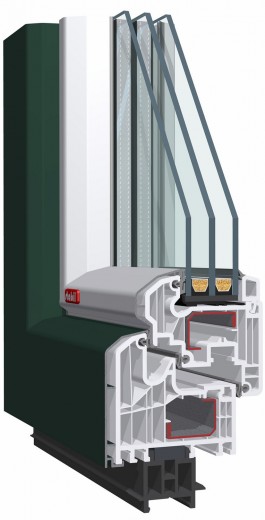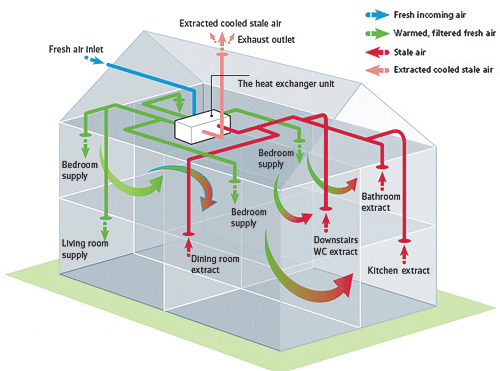ENERGY
TECHNOLOGY
Stay New Homes Energy Saving Homes will feature:
- Triple glazing, Increased Insulation, reduced Thermal bridging.
- Renewable Heat – Air or Ground Source Heat Pumps, Solar Thermal panels, Biomass Boilers.
- Mechanical Ventilation Heat Recovery system and improved airtightness.
- Energy storage – Rechargeable battery packs – solar energy from Photovoltaic Panels (PV).
- LED low energy censored lighting, Infrared heating.
- Rainwater harvesting.
Energy saving specification could differ per development
TRIPLE GLAZING
The physics involved here have been worked out in Germany by the PassivHaus Institute. It has shown what happens to the surface temperatures on various forms of glazing when it gets really cold outside and the internal air temperature is designed to be at 21°C:
Next to a single glazed window, the internal surface temperature is around 1°C.
Next to a double glazed window (2000 vintage), the surface temperature is around 11°C.
Next to a modern, energy-efficient double glazed window, the surface temperature is 16°C.
Next to a triple glazed window, with a centre-pane U value of just 0.65, the temperature is 18°C.
So you can see, that whilst a double glazed window is perfectly adequate, a triple glazed window is more comfortable because it stores the heat just that little bit more efficiently. It also improves airtightness and reduces noise levels.
Low Cost – Better Living
INCREASED INSULATION & REDUCED THERMAL BRIDGING
A thermal bridge (sometimes referred to as thermal bridging, a cold bridge or thermal bypass) describes a situation in a building where there is a direct connection between the inside and outside through one or more elements that are more thermally conductive than the rest of the building envelope. Resulting in decreasing interior surface temperatures.
To help reduce and eliminate a thermal bridge. We will increase insulation within the triple glazed window frames, provide insulation to structure steel and other metal components. Introducing porous concrete blocks on the first row of brickwork.
To achieve a wall U-value of between 0.10 W/m2k to 0.15 W/m2k, our wall thickness may vary with use of super insulation, typically a thick of kingpin kooltherm or similar with taped membrane is used. Other specliast external insulation will also be considered.
AIR SOURCE HEAT PUMP
(ASHP) are one of three types of renewable energy generator that absorb heat from sustainable sources (in this case, the air) and pump it through a compressor to increase temperature before using it to heat our homes.
An air source heat pump has quite a simple system compared to other devices. It includes a compressor, a heat exchanger and an evaporator coil. They simply take out heat from the air around it even if it is minus 15 degrees, so it can work in most climates. This heat is used to heat the water that is pumped through the under floor heating system.
Households could see a reduction in their annual heating bills of £300 to £700 on average.
Telephone – 01707 270525
(GSHPs) use pipes which are buried in the garden to extract heat from the ground. This heat can then be used to heat radiators, underfloor or warm air heating systems and hot water in your new home.
A ground source heat pump circulates a mixture of water and antifreeze around a loop of pipe, called a ground loop, which is buried in garden. Heat from the ground is absorbed into the fluid and then passes through a heat exchanger into the heat pump. The ground stays at a fairly constant temperature under the surface, so the heat pump can be used throughout the year.
The length of the ground loop depends on the size of the home and the amount of heat it will require. Longer loops can draw more heat from the ground, but need more space to be buried in. If space is limited, a vertical borehole can be drilled instead.
GROUND SOURCE HEAT PUMP
BIOMASS BOILERS
Wood-fuelled heating systems, also called biomass systems, burn wood pellets, chips or logs to provide warmth to central heating and hot water boilers and storage.
For our smaller homes we can install a stove burner that burns logs or pellets to heat a single room with a back boiler suitable for providing hot water heating. For larger homes and developments a biomass system, which requires suitable storage for the fuel pellets, logs and waste food. These fuel types would need to be regularly accessible in order to fuel the system. Depending on the development location it will determine if it is suitable to use a Biomass system.
A wood-fuelled biomass boiler could save you up to £880 a year compared to electric heating.
Low Cost – Better Living
PHOTOVOLTAIC & SOLAR THERMAL PANELS
Solar water heating systems use free heat from the sun to warm domestic hot water. Combined with the fitted boiler or immersion heater it can be used to make the water hotter, or to provide hot water when solar energy is unavailable. There is saving on hot water bills throughout the year.
Solar Photovoltaic (PV) system consisting of solar panels, an inverter and a generation meter. When light hits the silicon cells in the solar panels, electrical energy is created. This electricity then flows through a cable and is collected at a central point (usually located in loft).
Here the electricity is converted from DC to AC current and is carried into your household electricity system. The electricity it generates works using your existing circuitry to help power household appliances and lighting. The electric can also be stored and even used to power battery packs like the Telsa powerwall.
The power generated will dependant upon the area where the panels are positioned, typically the roof and its orientation to the sun for ultimate performance.
MECHANICAL VENTILATION HEAT RECOVERY SYSTEM
Our whole-house MVHR systems extract warm, damp air from the home and draw in fresh air from the outside. The warm, extracted air is passed through a heat exchanger to recover the heat before being expelled outside. The cool, fresh outside air is also passed through the heat exchanger, without coming into direct contact with the pollutant air where it is pre-warmed before being pumped in to the property.
An air filtration is built into our MVHR systems to prevent pollen and other particles from entering the home which then provides a more comfortable environment for allergy sufferers. Our systems typically run continually at 80% efficiency and are inaudible during normal use.
Because the fresh air is pre-warmed, heat loss from ventilation is largely avoided. This means you spend less on heating your new property, costs can be reduced by as much as £300 per year, therefore saving money and ensuring a healthy, well ventilated home.
Telephone – 01707 270525
New technology is emerging, market leading Tesla has announced a new product, which is being considered for our future properties. The system is called Powerwall! Its uses a high powered battery, that receives power from PV panels and may also be topped up with lower cost overnight electricity.
The powerwall unit is charged and ready for use throughout the property electrical circuitry system. This brings a new exciting dimension to energy saving.
ENERGY STORAGE
LED LIGHTING & INFRARED HEATING
LED lighting is now suitable for domestic use and easily compares with the typical 50w halogen bulb. We now specify LED lighting throughout our homes internally and externally. Cost savings are typically 70% cheaper then the equivalent 50w halogen bulb.
Infrared heating is now being featured in external applications, typically for garden parasols and awnings. Other considerations for this heating is for compact properties and bathroom heating.
We urgently require more land – with or without planning consent
RAINWATER HARVESTING
Rainwater is collected from the roof via guttering and downpipes. It gravity-feeds through underground drainage pipes and is then passed through a filter before entering the tank.
The filter removes any leaves or larger particles from the rainwater before it is delivered into the tank. This improves the quality of the water being stored in the tank.
The rainwater enters the tank through a calmed inlet device which prevents any sediments which may build up over long periods from being disturbed and discolouring the main body of rainwater.
A submersible pump is installed inside the below ground Rainwater tank. When the pump or controller senses a drop in pressure due to someone turning on a tap or flushing a toilet it starts to pump Rainwater water. This Rainwater is then automatically delivered by the Rainwater Harvesting unit to the point of use.
Typical use for the water is for toilet flushing, washing machines, garden irrigation, jet washing and car cleaning. Typically saving up to 50% on clean water used.






